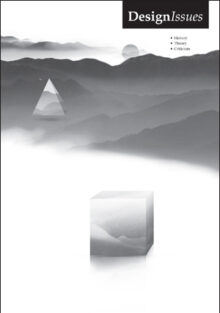peer reviewed articles

Design Issues, – MIT Press Journals (2019)
Baur, R. & Felsing, U. (2019). “On the Cultural Anchorings of Knowledge Visualization”, in: Design Issues, – MIT Press Journals, 35(1), 52–66. https://doi.org/https://doi.org/10.1162/desi_a_00520
This article concerns knowledge graphics from Chinese culture. These graphics are linked to specific designs based on concepts anchored in their own culture and time. The major question behind our research was: What kinds of special qualities do traditional Chinese diagrams have, as regards to their cultural framework and their specific design? At the heart of the research is the conception and creative development of “visual translations.” By redesigning existing knowledge graphics, the research team was able to perceive the cultural implications of the Chinese graphics.
Studies in Visual Arts and Communication
Baur, R. & Felsing, U. (2016). Researching Visual Application Respectful of Cultural Diversity. Studies in Visual Arts and Communication, 3(1). ISSN 2393 – 1221, https://tinyurl.com/k3rgdez oder http://journalonarts.org/wp-content/uploads/2016/07/SVACij_Vol3_No1-2016-Baur-Felsing-Researching-Visual-Application-Respectful-of-Cultural-Diversity.pdf
The general intention of this paper is to provide insight into a problematic area, that of visual application respectful of cultural diversity, and to demonstrate the relevance of graphic design research in a societal environment. The paper presents methods and results from two completed research projects in the field of intercultural visual communication. The key findings of Research Project 1 are methods of multilingual typography communicated by type specimens and text samples, annotations on books, visual examples from Chinese designers and texts. The most important results of Research Project 2 are visually communicated by 120 newly drawn infographics. In addition, a new research plan will be discussed, namely the development of visual identities for public institutions that implement cultural and social diversity policies. The proposed design methods in all three projects respond to the complexity of changing social requirements and forms of communication. They have been developed through visual applications of design that focus on the approach called “research through design.” The fundamental research goal is to practice sovereign interaction, also with visual differences, and thus counters the tendency of globalization and commercialization to equalize differences.
Review of Arts and Humanities
Baur, R. & Felsing, U. “The Visualization of Knowledge: Researching for New Methods for Information Design in the Intercultural Field”. In: Review of Arts and Humanities, Vol. 4, 2015, No. 1, pp. 27-41, http://dx.doi.org/10.15640/rah.v4n1a5
The aim of this research was to answer the following question: How can design provide access to visual sources of knowledge from other cultures? Diagrams from the Chinese visual encyclopedia Sancai Tuhui (1609) were exemplary of “foreign knowledge.” This paper focuses on the ways of re-drawing these diagrams as “visual translations.” The result of this research is the understanding that visible, visualized knowledge is always tied to cultural notions that are not always immediately visible. For a certain amount of time, these form the “reference system” for the images (see Goodman, 1968), in which social, ethical, historical, and media dimensions are linked. The research project, “The exploration of design methods in the area of crosscultural visual communication. Case study 1B: The coexistence of Chinese and Latin visual cultures,” was initiated by the Swiss National Science Foundation between 2010 and 2015. The research is in the field of communications design, and the field itself ranges from information design (practice) to visual studies (theory). In the practical area, our group based its research on works by Tufte (1983, 1990, 2005, 2006) and Bertin (1974); for the theory, we refer to Krämer (2009) and Goodman (1978). Adjacent disciplines are semiotics and Sinology.